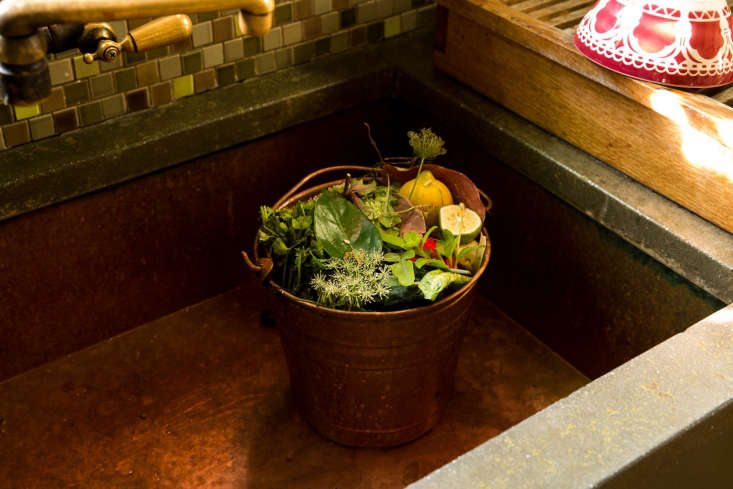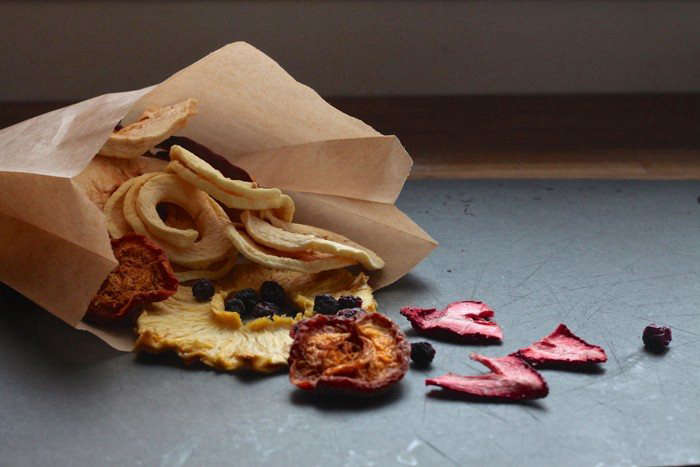Winston Chiu, Anastasia Cole Plakias, and I all are passionate about eliminating waste.
For Chiu and Cole Plakias, who host the annual Compost Dinner at the Brooklyn Grange, it's because they have lofty dreams of saving the planet with sustainable gardening, thoughtful food purchases, and efficient kitchen techniques. For me, it's because I would love to take out the trash less.
When I met Cole Plakias and Chiu a few weeks ago at their dinner, it quickly became clear that they could help me with this.
"When we talk about food waste," says Cole Plakias, vice president and founding partner of Brooklyn Grange, "we're not just talking about actual food material being scraped off of a plate into the trash—we are also talking about the energy that went into producing it: water, labor, herbicides, pesticides, harvesting, transportation, packaging, and shipping."
In fact, America is one of the world's most wasteful nations when it comes to food—almost half of all produce in the United States is thrown away annually, according to the Guardian.
"Reducing waste in the kitchen has to become part of a lifestyle," says Chiu, chef and co-founder of catering company BonBite and also known in my household as "the man who got us to eat garbage and like it," for his impressive Compost Dinner efforts. "You have to make it convenient. Be prepared. Have a few tricks up your sleeve."
Here are their t0p 10 tips for growing zero-waste food, from farm to table:
Grow Herbs, Not Tomatoes

Above: The life cycle of a chive. Photograph by Mimi Giboin for Gardenista.
"Instead of trying to grow something like tomatoes that take a ton of water, labor, and energy—and which you will always eat anyway, if you buy at the grocery store—start by growing herbs," says Cole Plakias. "You never eat the entire bunch when you buy them, and they are way more flavorful and delicious when you grow them yourself. And, you can grow something fun like chervil—you're never going to find that in the grocery store."

Above: Windowsill herbs by Erin Boyle. For more, see
DIY: Shade-Tolerant Windowsill Herbs.
Leafy herbs such chives, parsley, mint, cilantro, tarragon, oregano, and lemon balm are ideal for urban gardens, because they can flourish in lower-light spots.
Buy Ugly

Above: At the annual Brooklyn Grange Compost Dinner, chef Chiu composed a menu entirely from odds and ends, made delicious and beautiful. Photograph courtesy of
Brooklyn Grange Rooftop Farm and Anastasia Cole Plakias.
More than a fifth of the fruits and vegetables grown on United States farms don't meet the high standards of retail channels, like grocery stores. To combat the billions of pounds of waste this creates each year, seek out "misfit" produce—misshapen, discolored, smaller than average—at your local farmers' market, or through a box subscription service such as Imperfect Produce.
Pickle It

Above: After transforming a derelict walled garden into a thriving edible garden,
Katrin Scharl pickles vegetables every year. For more, see
Garden Visit: At Home with Katrin Scharl in Brandenburg, Germany.
Home-pickling is a technique that will lengthen vegetables' lifespan by months.
The most basic way to pickle is to submerge leftover vegetables (you can get creative here—think beyond cucumbers and carrots to beets, shallots, radishes…) in a mixture of vinegar, water, a little sugar, salt, and whatever spices you see fit. (See our Garden-to-Table Recipe: Pickles from a Cook's Garden.)
At one Compost Dinner, Chiu served a hot sauce made from pickled Brooklyn Grange peppers that had been salvaged at the end of last season.
Fermenting is a similar process to pickling, with a key difference—the sour flavor in fermented foods is a result of a chemical reaction between sugar and naturally occurring bacteria, versus added vinegar at the beginning of the pickling process.
Stock Up for Stocks

Above: Photograph by Lindsey Love. For more, see
Delicious Detox: A 20-Minute Turmeric-Miso Soup.
Save any scraps around the kitchen such as onion or garlic skins, the tough ends of leeks, animal bones, fish cartilage, and remnants of herbs—throw them into the freezer, and use them later to make a stock, says Chiu.
Toss everything into a pot, cover with water, and bring to a boil, before simmering for three-plus hours and then straining out the solids. Pro tip: Roast the bones first.
See the Appeal of Peel

Above: Photograph by Margot Guralnick. For more, see our recipe for
Homemade Orange-Spiced Wine.
Next time you use the fruit of an orange—or juice a lemon or lime—save that exterior. "It takes almost 14 gallons of water to grow a single orange," says Cole Plakias.
Use citrus peels to deodorize in-sink garbage disposals, or soak them in white vinegar to create a natural and effective all-purpose cleaner. (That is, if they survive cocktail hour without becoming garnishes.)
Save Stalks and Tops

Above: Chef Alice Waters keeps a compost bucket handy in her kitchen sink. Photograph by Daniel Dent for Gardenista. See more in
A Kitchen Tour with Alice Waters and Fanny Singer in Berkeley.
Get comfortable making pesto, and you can rescue almost any stalk, root vegetable top, herb, or leafy green that is on the verge of wilting. The basic recipe: In a food processor, pulse a couple of cloves of garlic with a handful of walnuts or pine nuts. Pulse in leaves, herbs, tops, and any stalks—give the latter a few quick chops beforehand if they're especially long or tough. Drizzle in olive oil, a handful of a grated, salty hard Italian cheese (parmesan, pecorino, grana padano), and salt to taste as you pulse. Modify away! You can use virtually anything to make a delicious pesto, including carrot tops, the stalks of kale or chard, and beet greens.
Tip: If you have a go-to sauté protocol, you will never throw away less commonly used greens again. One of my favorite rescue missions involves a quick sauté of radish leaves (which have a sharp kick) in ghee, with garlic, shallots, sea salt, a dollop of Calabrian chili spread, and a squeeze of lemon.
Dehydrate & Rehydrate

Above: Photograph by Justine Hand. For more, see
The Inside Story on Dried Fruit.
Chiu uses a dehydrating technique to extend the shelf life of items such as mushrooms. For the recent Compost Dinner, he was given several pounds of oyster mushrooms as a donation—the only problem was, he still had weeks to go before the event.
"I took them and dehydrated them to preserve, which gives the mushrooms a meatier, jerky-like texture," he says. Then, on the day of the dinner, "I rehydrated with water, and cooked them—then I used the poaching liquid from the mushrooms to dress another part of the dish like a jus."
To dehydrate mushrooms, cook on a baking sheet at a low temperature (about 150 degrees, give or take depending on your oven) for two hours, flipping once. Stored in an airtight container, dehydrated mushrooms can be kept upwards of a year.
Freeze It

Above: Photograph by Michelle Slatalla. See our recipe for
DIY: Rose Petal Ice Cubes.
Do you have fresh produce that's a day away from becoming mushy or molded?
"Freeze and use on another day," says Chiu.
Frozen chunks of stone fruit, bananas, and whole berries—or steamed-and-then-frozen vegetables like cauliflower, zucchini, and kale—can be used to make thick, creamy smoothies.
If you're feeling less virtuous (I typically am), frozen fruit can also make an excellent addition to upside-down cakes—as a bonus, using frozen berries or cherries (versus fresh) will create a beautiful, naturally occurring swirl pattern as the fruit thaws in the oven.
Put Away the Dishes

Above: Photograph by Matthew Williams for Gardenista. For more, see
Revolution Road: A Groundbreaking Kitchen in London.
When Chiu finds himself with leftover sinewy outer layers and leaves, he serves food on them—an opportunity to skip the dishes (and dish washing).
"When I buy something," says Chiu, "I think 'What am I going to make with this? What will I have left, and how will I utilize that?'"
At the Compost Dinner, Chiu used coconut halves as bowls for fish curry, banana leaves as plates (as well as steamer wrappers, for sticky rice), nasturtium leaves as taco shells, and oyster shells to serve sauce. With one larger banana leaf, he fashioned a shallow vessel for dip that accompanied crudités.
Put Your Flowers on Repeat

Above: Photograph by Erin Boyle.
Flowers can and should be used for several different events in a row. To keep them fresh for longer, refrigerate overnight, and stick a little apple cider vinegar and sugar in their water. And when it's time to say goodbye to fresh flowers, style a faded floral arrangement, turn them into decorative garlands, or press and frame them.
N.B.: This post is an update; it was first published August 2017.
For more ideas, browse our Sustainable Design posts, including:
0 comments:
Post a Comment